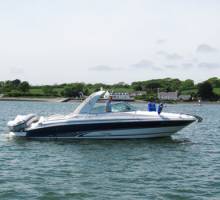
Insurance, whatever type of boat we still have to pay for something we hope never to use!
For us the beginning of June means boat insurance day. It’s the sailing season, we normally have loads of other things on our minds and this year the weather was glorious but in contrast to previous years where I’ve just called up credit card at the ready and renewed with our existing insurers I took the time to look into our policy and realised we weren’t correctly covered so I had to do a quick bit of research and found out an awful lot about boat insurance in a short space of time.
The first thing I discovered was all the different things that affect the price of the policy, the main ones seemed to be:
Where the boat is kept and the type of berth she is kept on
It’s not just whereabouts the boat is kept which you would obviously expect to make a difference to the policy but also if she is kept on a mooring, marina berth or out of the water in a boat yard.
The cruising range of the boat
You need to make sure that you are covered for everywhere you are going to sail but if you have a limited cruising range it will reduce your policy. Our mistake had been to keep adding new areas on but not taking the old ones off so we ended up paying for areas we had no intention of sailing to.
The current value of the boat
We just kept renewing the policy at the value we had initially insured our boat for but over time things change. In our case the value of our boat had dropped so we got a reduction in premium but speaking to a friend about this at the weekend he realised he was under insured. He’s been doing his boat up slowly over several years and upgrading all her equipment so she’s now worth an awful lot more than the bargain price he paid for her.
The excess you are willing to pay in the event of a claim
I increased the excess on my car insurance last year and got a huge reduction in the cost of the premium so I tried it with the boat insurance and sure enough it resulted in a reduction in premium so definitely worth asking about so long as you know you can pay the increased excess should the need arise.
The additional items to be covered on the insurance
The usual ones are tender, outboard and liferaft, they are normally itemised separately but a new tender meant we had to up the value in this area.
Then there was the small print, the exclusions and clauses which had prompted me to look into our insurance in the first place, these are the ones that affected us:
Time the boat is in and out of commission
I was surprised how much of a difference this makes, if you do take your boat out of commission each year then it’s definitely worth mentioning it to your insurers but by the same token if you decide to use her when you’ve said she’ll be out of commission you won’t be insured unless you notify your insurer and get their agreement first.
Restrictions for single handed sailing
We don’t single hand very often but even if one of you takes the boat back to the mooring while the other gets the car that’s single handed sailing and it’s not unusual for one of us to make the most of a quiet weekday afternoon to visit the fuel pontoon and fill up before the weekend rush so we needed this cover but every policy we tried had some restriction in this area. We’ve ended up with only being able to single hand during daylight hours which shouldn’t be too much of a problem but we will need to remember this when sneaking back late on a Sunday night.
Racing cover
This is one area that we could save money on but the different types of cover and the exclusions were mind boggling, I shall certainly need to go into this in very great detail should we decide to get back into club racing next year. Thankfully most insurers allow you to add insurance to cover specific events during the year so if we do decide to do the odd race we can get cover easily.
Waterski and towed toys
As we own a sailing yacht this wasn’t a problem but my brother who has a power boat always has to check this section very carefully to make sure he is covered when towing skiers and the specific restrictions which apply to who, when and where he can do this. He also warned that despite reinsuring with the same company these did change slightly each year.
Use of the vessel
For most of us its private and pleasure use but you do need to let the insurers know if you intend doing anything different, chartering, racing or living aboard all affect the policy.
And finally because we opted to change insurers there were a load more hoops to get through:
Proof of no claims bonus
This was fairly straight forward to obtain and pass on but needs to be done promptly to make sure the premium isn’t affected.
Survey
Most insurers require a survey for older boats. There doesn’t seem to be any consensus between companies for the age at which a survey is required or how often after that a new one must be completed. 2 years ago we had to get a survey for our insurers. This was a really interesting exercise and told us a huge amount about our dear old girl. Our new insurers now have a copy and this would have been OK for any of the companies I approached this time. However had I been with our new company 2 years ago the previous survey which was 5 years old would have been acceptable as they consider a survey to be valid if it is up to 10 years old.
The proposal form
I recommend a quiet time and no distractions to wade through this form. The questions aren’t difficult but it is quite a lengthy process and knowing that it may affect a claim later means you do need to get this part right.
Here at Boatshed we do have plenty of information from different insurance companies and it was easy for me to quickly find out what I needed to know. Companies do advertise in the Yachting Press and the internet is a ready source of information but I do need to say a big thank you to Liz at Velos Insurance for making some very valid points. She’s happy to look at any Boatshed customers’ boat insurance requirements or give you an insurance "health check"





